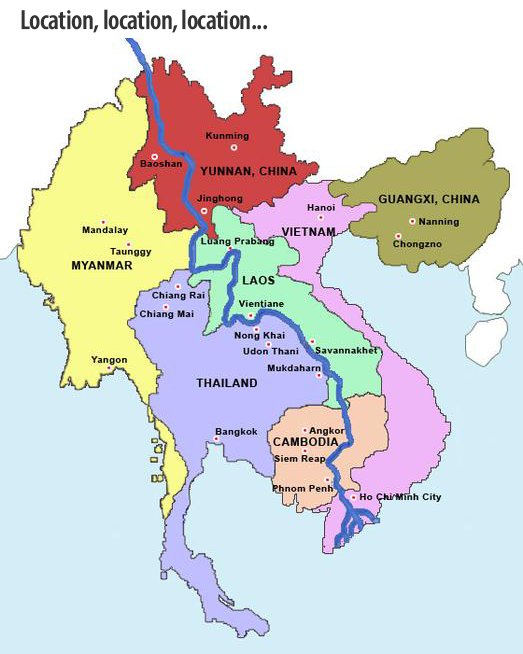
World's 4th Largest Economy 2050
Observations from Southeast Asia
For robot tech producers, unprecedented opportunities await in Thailand as well as Malaysia
gross domestic product (GDP) is $2.4 trillion… the seventh-largest economy in the world
and is forecast to jump to fourth by 2050.”

Tom Green and Dr. Djitt Laowattana
The Godfather of Thai Robotics
Asian Robotics Review had an insightful and deep look into Thai automation and robotics with Dr. Djitt Laowattana, Founder & Director of Institute of Field Robotics, King Mongkut’s University of Technology, Thonburi.
Djitt’s experience and expertise in Asian automation and robotics offers our 20,000 readers and visitors unparalleled insight into the forward direction of robotics, automation, and artificial intelligence at the epicenter of the Fourth Industrial Revolution—Asia!
Dr. Laowattana’s journey through the world of robotics:
- Bachelor of Engineering (with honors) in Mechanical Engineering, Faculty of Engineering, King Mongkut’s University of Technology Thonburi. 1979
- Master of Precision Mechanics, Kyoto University, Japan 1988
- PhD., Carnegie Mellon University, U.S.A. 1994
- Certificate in Management of Technology and Innovation, MIT, U.S.A. 1995
Forthcoming on March 25th is our full interview with Dr. Laowattana. See why he’s called The Godfather of Thai Robotics!
Thailand: The Cringe Factor
A recent survey reported by Modern Manufacturing Thailand, says 85% of Thailand’s factories and warehouses are “manual” yet 1 of every 3 is looking to upgrade to automation. The problem: They don’t know how.
Walk into most any SME factory or warehouse and the “cringe factor” immediately jumps out at you: Someone is doing something on an utterly dangerous job that could easily be done by a robot, especially a cobot. Welding and brazing look like accidents ready to happen at any moment. Oddly enough, the factory or warehouse owner has the capital readily available and is willing to spend to switch out the human for a cobot, but doesn’t.
Many of these end users are visitors to Asian Robotics Review; they see how robot-driven automation changes productivity for the better, and they understand that ROI is many times a slim 6-month jaunt to payback.
In most cases, the SME owners do not lack for financing to automate. But if they do, the Ministry of Industry “supports low-interest loans for SMEs to improve production efficiency using robots and automation” through the SME Development Fund.
So what’s the holdback? Thai SMEs, by and large, are comfortable with business as usual, although they know that sometime soon they will have to break the cycle of low productivity…and the tailspin of a working population that is aging fast.
Many have suggested that Thailand increase the number of its system integrators from 200 to 1300, while, at the same time, trying to avoid the problems China had with its integrators, which was mainly lots of people out to game the system and soak up easy money without delivering the necessary automation integration.
South China Morning Post is reporting: “Mainland China’s growing robotics sector has allegedly been overrun by domestic companies which have fraudulently obtained vast amounts of subsidies from various local governments.”
In Thailand, going from 200 to 1300 system integrators will be a huge job; and vetting them all will take enormous amounts of time, even if fast tracked.
See: How to Sell Cobots in Thailand

Lack of gripper mindset
Unless it’s for a big auto manufacturer or for electronics or pharmaceuticals production, getting the right gripper for the right job does not compute too well, especially with SMEs. Whether in Shanghai or Bangkok, using what’s readily and inexpensively available seems always to be the preferred option, until shown otherwise.
To buy a finely crafted, efficient and easy-to-use gripper takes some convincing. In the end, the value of a relatively expensive but superb gripper is easy to demonstrate to any factory or warehouse owner; they get it! It’s as simple as show and tell, which means educating the customer. And that’s where system integrators are supposed to come into play; but with only 200 system integrators (Thailand), getting to masses of SMEs will be a herculean feat.
In China, with only 3,000 cobots sold in all of 2017, the problem is exacerbated more than a bit: Who is going to take the time to understand the value of having the right gripper when the cobot is still a mystery?
Bullet points to Thai success
- Thailand has a 3-year plan to lower the “manual” factory/warehouse rate from 85 percent to 50 percent.
- A 5-year plan to create 150 domestically-built prototype robots
- A 5-year plan to transfer robot technology to 200 Thai entrepreneurs; and
- To train 25,000 people for the robotics industry

Then there’s nearby Malaysia
Under the Eleventh Malaysia Plan, 2016-2020, the government aims to increase productivity in manufacturing through a two-pronged strategy of “increasing automation and enhancing workforce skills development”. Malaysia’s planned for Robot City will become critical to the success of the plan.
There’s a ready industrial need to improve productivity via robotics. However, there is a scant workforce capable of operating all these robot wonders. The breakdown: 75 percent semi-skilled, 7 percent low skilled, and 18 percent skilled.
In short, there’s little of a robotics ecosystem in Malaysia. The Malaysian Robotics and Automation Society (MyRAS) has published a study that identifies and addresses the near-term demands of the robotic industry in Malaysia.
It’s extensive, pointing out a shortage of 160,000 robotics professionals in five skills areas: managers, technicians, engineers, supervisors, and operators; the need for 200 vendors/service providers; and shortages of specialized knowledge in seven areas ranging from algorithms to IoT.
The bottom line
Both Thailand and Malaysia offer boundless opportunity for themselves as well as for any tech company willing and able to help these countries grow to their full potential.
